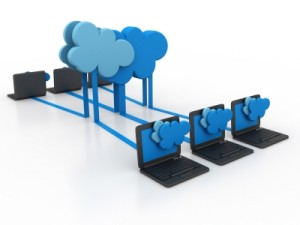Public Cloud Concerns: Myth vs. Reality
 Despite the increasing popularity and adoption of cloud services, many misperceptions still abound about their potential disadvantages. Companies considering a cloud service purchase should carefully sort through both the hype and the myths about cloud computing before making a purchasing decision.
Despite the increasing popularity and adoption of cloud services, many misperceptions still abound about their potential disadvantages. Companies considering a cloud service purchase should carefully sort through both the hype and the myths about cloud computing before making a purchasing decision.
Cloud misperceptions vary, but three primary myths have emerged that might cause IT decision makers to stop and reconsider their cloud purchase plans. However, the reality behind these myths should give buyers reassurance when it comes time to make a cloud decision.
The Data Center Death Knell Myth
With data and functionality increasingly moving to cloud services, IT employees may be concerned about being replaced by the very technologies they choose to deploy.
While this isn’t a completely unfounded concern, the reality is that cloud services are largely being adopted by younger and smaller companies that don’t already have in-house IT departments. The ability of the cloud to provide IT services that such companies would otherwise have to build from scratch is one of its primary advantages.
For companies that already have an established IT team, cloud services aren’t likely to steal away jobs anytime soon. Companies may move some of their data and processes, particularly storage, to the cloud, but most companies will continue to house critical data on private networks in a hybrid approach. In-house IT will continue to be needed to support private network operations.
The Security Myth
One of the most common and persistent misperceptions about the cloud is that it opens up companies to a variety of new security risks. The thought of having data leave the safety of the corporate security fortress and travel via potentially unprotected connections to a public cloud creates concern over attacks on a company’s critical data.
In reality, because of their singular focus on providing data services, cloud providers often have some of the best security experts on staff who focus entirely on predicting security vulnerabilities and protecting against attacks on client data.
The Data Black Hole Myth
Some companies worry that once they allow their data to transfer to a cloud service, they will lose control over it or have difficulty moving it or getting it back. This myth likely circulates because in the past, it had some truth to it. Making a cloud transition sometimes meant data was locked in with the chosen provider.
But trends surrounding this cloud concern are changing. Some of the larger cloud providers offer tools that make it easier to control and move data when the company chooses. Amazon’s Snowball appliance allows customers to easily migrate data, and Velostrata introduced an appliance that eases the migration of data to and from the public cloud.
Making an Informed Cloud Purchase
Cloud services provide many benefits to companies that want to improve their operations and increase efficiencies. IT decision makers have a responsibility to choose a cloud service that protects the company’s data assets and provides the right services for its users.
All technologies have pros and cons. Deciphering myth from reality surrounding security, data availability, and future IT employment can help decision makers make the right cloud choice.
Keeping Your Business Secure While Using an IaaS Plan
 Infrastructure-as-a-Service (IaaS) plans benefit a business by offering access to a cloud-based infrastructure that is tailored to their specific needs. However, many businesses are concerned with keeping their data safe with IaaS.
Infrastructure-as-a-Service (IaaS) plans benefit a business by offering access to a cloud-based infrastructure that is tailored to their specific needs. However, many businesses are concerned with keeping their data safe with IaaS.
When subscribing to an IaaS plan, here’s how businesses can protect their sensitive data.
Awareness of What a Business Controls
Business users who subscribe to an IaaS plan should be aware of exactly what their plan entails. This includes the configuration of the infrastructure and how users will be able to access different data. By being aware of what they need to control, businesses will be knowledgeable and informed about the security of their plan.
Ownership
It’s important to know who owns the data within the infrastructure. Understanding ownership details enables a business to navigate logistical situations and protect the organization against legal factors.
The Service Level Agreement
By understanding the Service Level Agreement (SLA), businesses help protect their data and intellectual property. An SLA is a fluid document and should be treated as such.
Complying With Regulations
In order to keep their IaaS secure, businesses need to be aware of industry regulations. Businesses should ensure that their IaaS provider is willing and able to work with them to fine-tune the management of processes and configuration capabilities.
User Authentication
Cloud hosting plans are completely virtual and not necessarily hosted within an organization, which means end user authentication can present a high security risk. Employees should keep login credentials private and be properly trained in authentication best practices. This doesn’t mean that end users should be inconvenienced or restricted; technology leaders should lead by example when establishing best practices, and businesses should find the balance between security and convenience for their users.
Monitor the Network
Even with the best security in the world, a business may run into issues with their IaaS if network monitoring is lacking. It is important to know and understand the network in order to catch unauthorized activity before it turns into a security breach. Monitoring the wireless infrastructure — especially as many users are now employing mobile devices to connect — will also prevent unauthorized users from accessing the cloud.
Employee Training
Employees aren’t always aware of how security holes can be created. Something as simple as accessing the infrastructure through a public Wi-Fi hotspot can create major security risks. Businesses can easily reduce these risks by training employees to understand how best to keep their connection secure.
Data Backup
Businesses must be aware of how their IaaS provider handles data backups, especially if using a new provider. Understanding the vendor’s redundancy procedures and being able to take action allows a business to protect their assets.
Data in Transit
Data moving between users, the data center, and the location of the IaaS systems can come under attack in different ways. In order to enhance security as much as possible, businesses must understand how this data moves.
Internal Unauthorized Activities
Users with authorization might still perform unauthorized activities. As well as ensuring that employees understand best practices, businesses should also ensure that the IaaS vendor has professional staff members and can control potential internal issues.
IaaS vendors assists with security strategies, but it never hurts for a business to have their own plans in place. By understanding their plan, monitoring their network, and ensuring that all staff members follow best practices, businesses have the ability to data safe.
How Cloud Computing Benefits Start-Ups and Small Businesses
 As recently as a few years ago, entrepreneurs requiring computing solutions would have had little choice other than to make major IT investments. However, the advent of the cloud has changed the playing field, both for business owners and their customers.
As recently as a few years ago, entrepreneurs requiring computing solutions would have had little choice other than to make major IT investments. However, the advent of the cloud has changed the playing field, both for business owners and their customers.
Recent studies have quantified the impact cloud computing has had on global businesses; according to Gartner, a leading market research firm, cloud computing services generated over $150 billion in revenues in 2014.
The cloud offers a convenient and cost-effective alternative to traditional IT delivery methods, allowing entrepreneurs to access and customize software programs, data storage and backup services, and a wide range of other specialized functions and applications over the Internet.
Major benefits of the cloud include:
- Significant cost reductions – Cloud solutions reduce the need to purchase in-house hardware and software. The cloud also eliminates the need for physical storage and backup of files and documents.
- Scalability and flexibility – Cloud technologies can be upsized or downsized according to the changing needs of a business.
- IT savings – Cloud-based applications reduce resource or eliminate demands on in-house IT departments.
Cloud Computing Deployment Methods
Businesses seeking to take advantage of cloud computing have four main deployment methods available:
- Public cloud – This deployment model is easily accessible, hosted on the World Wide Web.
- Private cloud – Companies can create private clouds behind firewalls for added security.
- Community cloud – This model is a partnership of companies or organizations sharing the same private cloud space.
- Hybrid cloud – An emerging deployment approach that combines aspects of the private, public, and community cloud models, creating a customized, flexible solution.
Business Functions Supported by Cloud Computing
Cloud computing has a wide range of applications in the business world, but there are four primary ways in which the technology is used:
- File storage and data backup – Cloud computing has emerged as the most flexible and convenient way to store files and back up important data. The remote storage of digital documents frees up much-needed space on local devices. Cloud technologies also offer secure data backup capabilities, ensuring business continuity in the event of a disruption.
- Collaboration – Cloud computing has transformed the workplace, making it much easier for people working from different or remote locations to communicate, collaborate and share information. Roughly two-thirds of small and medium-sized enterprises report the need for employees to be able to work anytime, from anywhere. For businesses such as these, cloud solutions offer a major boost to productivity and operational efficiency.
- Resource accessibility – Software, data, and documents stored in the cloud are quickly and easily accessible. Server management is monitored by cloud providers, further liberating businesses from administrative costs.
- Effective management of business growth – In the past, growth forced businesses to make further investments in IT resources. Now, the near-instant scalability of the cloud provides flexible, cost effective computing resources.
How to Choose a Cloud Provider
Businesses should carefully assess cloud providers based on terms, pricing, and service level agreements, as well as security and reputation. Many providers offer low-cost trial periods, which businesses can take advantage of to test compatibility.
It’s important to make a thorough needs assessment in partnership with providers. Topics to address should include:
- The best deployment model
- Security needs
- Software, infrastructure, and platform requirements
- The availability of new applications
- Merging existing IT infrastructure with the cloud environment
The cloud offers a scalable, flexible, affordable route to improved IT performance that is ideal for businesses with limited IT resources.
Debunking Common Virtual Security Myths
 When it comes to deploying security in a virtual environment, some industry professionals draw a blank–or, worse, they think that it’s necessary to replace existing physical security protocols with virtual substitutes. This is not true.
When it comes to deploying security in a virtual environment, some industry professionals draw a blank–or, worse, they think that it’s necessary to replace existing physical security protocols with virtual substitutes. This is not true.
In fact, the best approach to use when viewing virtual security is a logical one. Consider this: A jewelry store owner who expands the physical location or who opens a new facility would not try to use his/her current security force to protect the new location, nor would the owner secure the new location by trying to stretch the current security force between two facilities and simply hope that the depleted resources will cover the need. Both sites need to be secure.
Considering the current, overwhelming surge in virtual as-a-service solutions, knowing how and when to apply virtual security measures like firewalls has become a crucial consideration for businesses. This is especially due to the fact that according to industry specialists, over one-fifth of all VPN (virtual private network) security will be deployed in a virtual format by the end of the year.
Layered Security
Companies already understand the flexibility and cost-saving advantages of moving information and even key infrastructure to the cloud (hence, the rapid growth). That said, virtual security protocols should not be an either/or dilemma; they should be employed in a layered defense. The physical systems already in place should be supported with virtual firewalls—not replaced with them—depending on the level of the workload requirements.
The reasons for this layered defense are abundant. Not only does it secure the virtual aspects of the data system, but the same ease of alteration and on-demand access that is available in a virtual environment is accessible with virtual firewalls. Companies can adjust deployment according to specific needs, which allows them to better control financial commitments.
Deployment Confusion
The issue of deployment confusion has been discussed at length by industry experts. Keeping pace with the rapidly expanding network services available in a virtual environment means finding ways to secure that activity from threats.
Therefore, deployment should depend on the same workload and accessibility requirements that have determined the current physical security measures.
Notably, there are two basic types of virtual firewalls:
- Introspective: This type resides within the hypervisor side of each virtual NIC (network interface card). Although it offers a well-managed way to keep virtual machines protected, it is limited in availability at this time.
- Edge: This is the most common form of virtual firewalls. These reside between two or more virtual portgroups or switches. The beneficial aspect of this type of virtual security is that companies can deploy them at the “edge” of their data center or between trust zones in a cloud environment, depending on their workload and throughput activity.
Rules of the Game
In general, there are three fundamental rules when it comes to adding virtual security services to a network:
- Deploy virtual firewalls to enhance the depth of network safety in conjunction with the physical securities already in place.
- Know the specifications of a virtual firewall. (The specs for physical firewalls are outlined; virtual ones should be outlined, too.)
- Don’t limit virtual security to one type (or breed) of firewall. (Requirements play an essential role in the types and amount of firewall protection needed for a network.)
With the changing environment of virtual services, companies can discover the best means of keeping their networks secure by incorporating virtual security protocols. The investment is well worth it when the risks are considered, and the faster, more adaptive role that these protocols play can make a huge difference in security compliance.
Hybrid Cloud Paves the Way for IT-as-a-Service
 With Cloud computing rapidly becoming an essential part of many companies’ offerings, organizations of all sizes are starting to embrace the newest trend, IT-as-a-Service (ITaaS). By employing a hybrid Cloud – a combination of private Cloud and public Cloud solutions – these companies are able to tailor their IT environments to match their own unique needs and long-term goals. Along the way, they are ensuring greater flexibility with their IT solutions.
With Cloud computing rapidly becoming an essential part of many companies’ offerings, organizations of all sizes are starting to embrace the newest trend, IT-as-a-Service (ITaaS). By employing a hybrid Cloud – a combination of private Cloud and public Cloud solutions – these companies are able to tailor their IT environments to match their own unique needs and long-term goals. Along the way, they are ensuring greater flexibility with their IT solutions.
Why is ITaaS gaining such a following? Taking a look at a few predictions from Gartner gives some insight into the reasons. By 2016, it is estimated that the majority of new IT spending will be allocated to Cloud computing; by the end of 2017, almost half of all large enterprises will have adopted the hybrid Cloud.
Companies have to be prepared to make the most of these shifts if they expect to remain agile and competitive. Likewise, businesses that provide IT services or advice to corporate clients must be poised to help those clients build a hybrid Cloud solution that will most effectively support ITaaS.
The mix will differ for every company.
Ultimately, companies will want to retain functions that are unique or otherwise enterprise-critical. They then can source the rest to the public Cloud.
This will require evaluating the cost-benefit of each option to determine the optimal blend, which will be based on overall business goals and operational needs as well as on regulatory and security requirements. Companies will need to assess costs, too, to find the ideal balance of performance and spend.
A growing number of companies most likely will look to establish software-defined data centers (SDDC), which is an environment that maximizes automation of computing, storage, networking, and security resources through virtualization. This provides an excellent foundation to support ITaaS.
Hybrid Cloud delivers significant benefits.
The fundamental value of hybridization is choice. With the ability to configure an individualized private-public Cloud combination, companies can expect to see benefits like the following:
- Vastly increased flexibility that enables implementation of ITaaS.
- Scalability of functions without sacrificing security.
- Less stressed or more productively deployed IT staff.
- Smoothly integrated internal and public workloads.
- A more dynamic IT environment.
- Greater visibility of services and costs, including IT usage by line-of-business.
- Improved ability to manage compliance requirements.
- Enhanced customer service.
Current IT trends represent best practices for implementing ITaaS.
IT is no longer a segregated support service; it permeates every aspect of a business’s functions and can make or break a company’s ability to grow and thrive.
Eliminating IT silos allows companies to view IT as a strategic business tool. As IT is taking its seat at the C-suite table, companies are realizing that a flexible, scalable IT environment is the only way to meet rapidly changing internal needs as well as external marketplace conditions.
As with any transformational change, top-level buy-in is essential to ensure that ITaaS is a success. Equally important is educating IT personnel on the positive value of this change: how it will benefit them in their job as well as the company as a whole.
To pull it all together successfully, companies must assess their IT infrastructure, workloads, and flows in order to identify the optimal hybrid Cloud configuration for them.
The Internet of Things Needs the Cloud
 Experts are playing the name game.
Experts are playing the name game.
There’s Cisco’s Internet of Everything, IBM’s Smarter Planet, MIT’s Ubiquitous Computing, and The Economist’s The Thingternet. You may even hear it referred to as “Machine-to Machine (M2M)” or “Device-to-Device (D2D) Communications.”
Call it by any other name, but the Internet of Things (IOT) is simply a massively interconnected network of people, processes, machines, and things made possible through the Cloud. Cisco has created a methodological connections counter to track how the IOT components are being connected each day. Its network engineers calculate the economic value of IOT to be $19 trillion.
International Data Corporation (IDC) likewise forecasts billions of things to be connected and trillions of dollars in economic development in its study on IOT spanning the period 2013-2020. This just goes to show the immensity of IOT and how it will impact the future IT world and people’s lives.
The Internet of Things is all around us
IOT is not limited to computers and mobile devices like smartphones, tablets, and iPads. It includes just about anything that can be installed with a sensor.
IOT can be found at home. There are home thermostats that sense when people are home or not and adjust accordingly for comfort and cost savings. For an example of kitchen-related IOT, Electrolux is in the final stages of developing an intelligent refrigerator that comes complete with a microphone, speakers, and video camera. Its computer can suggest groceries needed and places to buy them, as well as meal recipes based on ingredients available in the refrigerator.
We can also see IOT when we travel, as new cars include about 50 or more computers. With navigation tools, virtual maps, performance indicators, automated gauges, timely alarms, and more, travelers can be assured of safer trips and smoother traffic flow.
Then there’s Wal-Mart’s famous RFID tag that monitors their global supply chain and ensures products reach their destinations at the right places at the right time. Coca-Cola’s interactive vending machines, which are projected to reach two million in a few years. And UPS connects thousands of delivery trucks to the Internet to make delivery faster.
IT scientists foresee that many more ordinary things will become intelligent as the Internet of Things gains steam. For instance, sensors can be scattered all over rainforests to prevent illegal logging. Sensors can also protect fruits, vegetables, and other produce from spoilage. They can keep farm animals from getting sick, and rivers from being contaminated.
The Internet of Things is limitless.
The Cloud is behind the Internet of Things
What makes the interconnectivity of things possible is a network of Cloud-based systems. Many companies simply don’t have the capability to provide a fail-safe network to support their IOT. The abundance of the Cloud has all it takes to support the high requirements.
IOT is not just about connecting things but looking for a Cloud-based service that can support an immensely interconnected ecosystem capable of enabling all the connected things. SDN, virtual network overlays, network service virtualization, borderless admission control, and security are critical options that need to be considered.
Platform as a Service: The Nucleus of Business Agility
 Business growth remains a top priority for CEOs as the world is being consumed by software. CEOs wanting to grow their businesses is not news; what’s news is how they should plan to do it.
Business growth remains a top priority for CEOs as the world is being consumed by software. CEOs wanting to grow their businesses is not news; what’s news is how they should plan to do it.
According to a new study by Gartner, businesses that leverage new software development are likely to be more profitable than their competitors.
Software development is not just an emerging trend; it is a turning point to jumpstart a new platform – Platform-as-a-Service (PaaS). If used effectively, PaaS could be a powerful tool for agility in order to survive, compete, and thrive in today’s high-speed markets.
PaaS as a Turning Point
In a highly networked world with massive data, software is a preferred way for companies to do business and communicate with their customers and peers. Businesses across all industries need to reposition themselves around PaaS as a turning point for survival and growth.
PaaS is a cutting-edge software technology that ensures high-speed application development and deployment. It could lay the foundation of a network of software that can be customized according to the needs of business. Data, applications, speed, business intelligence, and analytics can all be put together in one platform so that businesses can grow dynamically to meet the changing needs of doing business and servicing customers.
PaaS as an Agent for Innovation
PaaS is basically a middle layer platform of tools, software, and middleware used to create applications delivered over the Web on-demand. It is a cost-effective and convenient way of developing, testing, and introducing new and better solutions more quickly than traditional methods.
PaaS engages application developers. Installing infrastructure, operating systems, application servers, adequate storage, and backup systems take time. PaaS substantially shortens the application development cycle because everything is automated. This engages developers to focus on their core responsibility of speedy application delivery.
PaaS saves time and money. Optimizing development time makes organizations more aggressive in introducing new solutions and products. If the cost for application development is reduced, ROI could be more robust. This encourages businesses to take more chances to constantly find more opportunities for growth.
Paas enables the delivery of unique value. Many business applications–including HR, CRM, ERP, and accounting systems–are often commoditized solutions that allow no differentiation from those of other organizations. If a company wants to stand out and deliver unique value, it needs a new kind of platform like PaaS to create custom applications for the company’s unique requirements.
PaaS enhances customer satisfaction. PaaS not only speedily builds and delivers applications; it also monitors and analyzes information on usage and user experience. It thus allows the rollout of fast and new updates to continually enhance customer satisfaction.
Paas allows unlimited cloud service choices. Being portable and flexible, applications managed in a PaaS environment can be moved and scaled across a variety of platforms. The ability to mix and match resources and applications based on unique business requirements gives businesses the freedom of choice for the cloud platforms they need.
Innovation Matters
Businesses that relegate innovation to the backseat are doomed to disappear.
Consumer electronics is one of the most vulnerable categories–as evidenced by old brands dying and new brands coming in. For instance, point-and-shoot cameras are a fading breed because of the entrance of smartphones that have innovative cameras. Print media is also on a slow death due to the legacy costs of printing and distribution compared to its online competitors.
Some brands in retail, manufacturing, hospitality, health, and education that continue to fall behind in innovation face the real threat of extinction. PaaS is your best bet if you don’t want your business to follow suit.
How CIOs Adjust Their Roles to Meet Their Organization’s Needs
 Technological revolutions such as the emergence of cloud computing and social media have made CIOs readjust their roles. Here is a look at why their roles changed thanks to these innovations.
Technological revolutions such as the emergence of cloud computing and social media have made CIOs readjust their roles. Here is a look at why their roles changed thanks to these innovations.
Why CIOs roles are changing
With the popularity of cloud computing and big data analytics, CIOs must balance their current responsibilities while also determining which of these current trends their businesses should use. For many CIOs, this may mean changing their responsibilities within their company.
Using the example of cloud computing, here are several ways this new technology forces CIOs to change their responsibilities:
- Less maintenance: Many CIOs oversee their organization’s servers and networks, but with cloud computing, service providers do this for them. Further, service providers update software as new versions become available so CIOs don’t have to manage this aspect either.
- Change in expenditures: When companies transition their software and data over to cloud service providers, CIOs must determine how much their companies should pay for these services, while also reducing cost on storage hardware they no longer need.
- Change in role: With many organizations moving to cloud-based technologies, CIOs discover they play a more strategic role within their organization’s structure since they have the time to focus on strategic planning instead of daily maintenance tasks.
Overall, these changes can sometimes lead to greater leadership opportunities for CIOs. According to IT News Africa, 67% of CIOs have more leadership roles outside of IT. This illustrates just how important CIOs are in transitioning their companies to these new technological trends.
How CIOs can Adapt
Simply, when companies decide to transition to new technologies, the CIOs can display their value in multiple ways. Here is a look at some of the roles they can fill:
- Chief Digital Officer: According to Gartner, one in five CIOs already fill the role of the CDO. The CDO is responsible for helping their companies in digital commerce while also identifying new technologies that can benefit their businesses.
- Chief Outsourcing Officer: When organizations decide to try cloud computing, the COO’s job is to determine which programs, software and data the company decides to outsource and which ones they should keep within their company.
- Chief Cloud Broker: One of the biggest adjustments for CIOs is when they take on this role. By finding a reputable service provider that offers secure cloud-based platforms, the CCB’s primary role is to build a relationship with that service provider to ensure the provider is able to meet the organization’s needs. This role is more relationship-based than the traditional CIO’s role of problem solver.
- Chief Insight Officer: One of the best ways CIOs can show their value is by providing their companies with well-analyzed data so the executive board can make sound business decisions.
- Chief Innovation Officer: The CIO explores new ways to conduct business by researching technological trends and determining which trends are right to employ for their businesses. In this case, the CIOs becomes more like business engineers, as they research and develop innovative ways to keep their company up to date on the latest technological offerings.
Ultimately, CIOs have shown a remarkable ability to adapt to emerging technologies. As technologies such as cloud-based platforms continue to rise in popularity, the role of the CIO will continue to evolve.
Cloud Computing: Multiple Benefits for IT Administrators
 IT administrators have a difficult job.
IT administrators have a difficult job.
According to a survey conducted by GFI, 77% of the IT admins surveyed said their job was stressful. There are many reasons for this: they must maintain systems regularly, troubleshoot problems with applications, and make sure security tools are updated and running efficiently.
Combined, these tasks take up much time and can often lead to stress and longer work hours. One solution for IT admins to consider is cloud computing.
Assistance in the Cloud
Cloud computing can take some of these daily burdens away and give IT leaders more time to focus on strategic development instead of daily maintenance tasks.
Here are just some of the many benefits cloud computing offers IT admins:
- Automatic updating: Since the service provider for the cloud updates software, it means that is one less thing IT admins have to worry about.
- Easier storage options: Similarly, cloud platforms give organizations a way to securely store their data, which means that IT doesn’t have to spend time maintaining storage hardware.
- Versatility: Accessing programs through cloud-based platforms is much easier: all the employee needs is a reliable internet connection. This means that employees can access their data from the office, home, or even a coffee shop.
- Uniformity: Since everything is internet based, IT professionals can access this information from remote machines. This means that they don’t have to spend time installing programs on every company computer.
- Reduced workload: In the same survey by GFI, sixty percent of IT admins say they work at least six hours of overtime a week now. However, with all the benefits that cloud computing offers, it may reduce their work weeks or at least give them the opportunity to do some of this work from home.
Unexpected Value of the Cloud
When companies switch to cloud computing, it changes the role of IT professionals. Instead of spending their days maintaining software, they can become more hands-on in developing new strategies to help their businesses grow to meet their customers’ needs.
A great example of this is Electronic Arts. When the company moved some of its programs to a cloud-based platform, there was concern that the IT department may have to cut jobs or that the department would lose money.
Instead, what they discovered was that the company’s IT department didn’t have to spend time on maintenance. Instead, IT was able to spend more of their days strategically planning developments that would help drive revenue. In short, IT aligned its vision with the larger company’s vision, creating a win-win situation for all.
Overall Alignment
Companies need IT professionals more than ever when transitioning to cloud platforms. Therefore, IT admins who can adapt quickly to change become even more valuable to their company; in some instances, they can develop a strategic role in helping their company plan for the future.
Ultimately, cloud computing offers a versatile array of benefits that can make the jobs of IT admins easier. Considering the daily stress already put on them, cloud computing represents an opportunity for them to lessen their workload. Meanwhile, it frees up time for IT leaders, allowing them to pursue collaborative opportunities with other company decision-makers.
